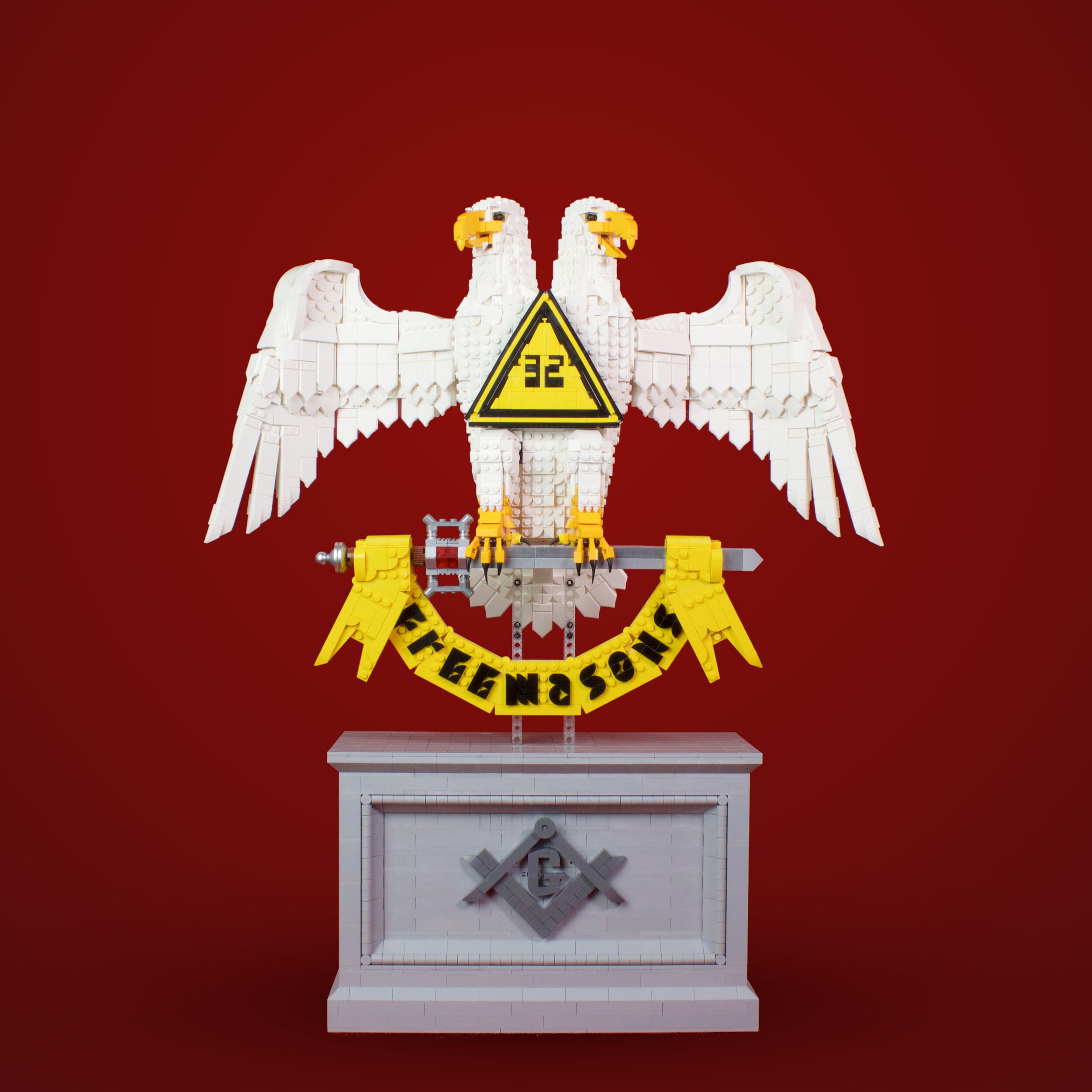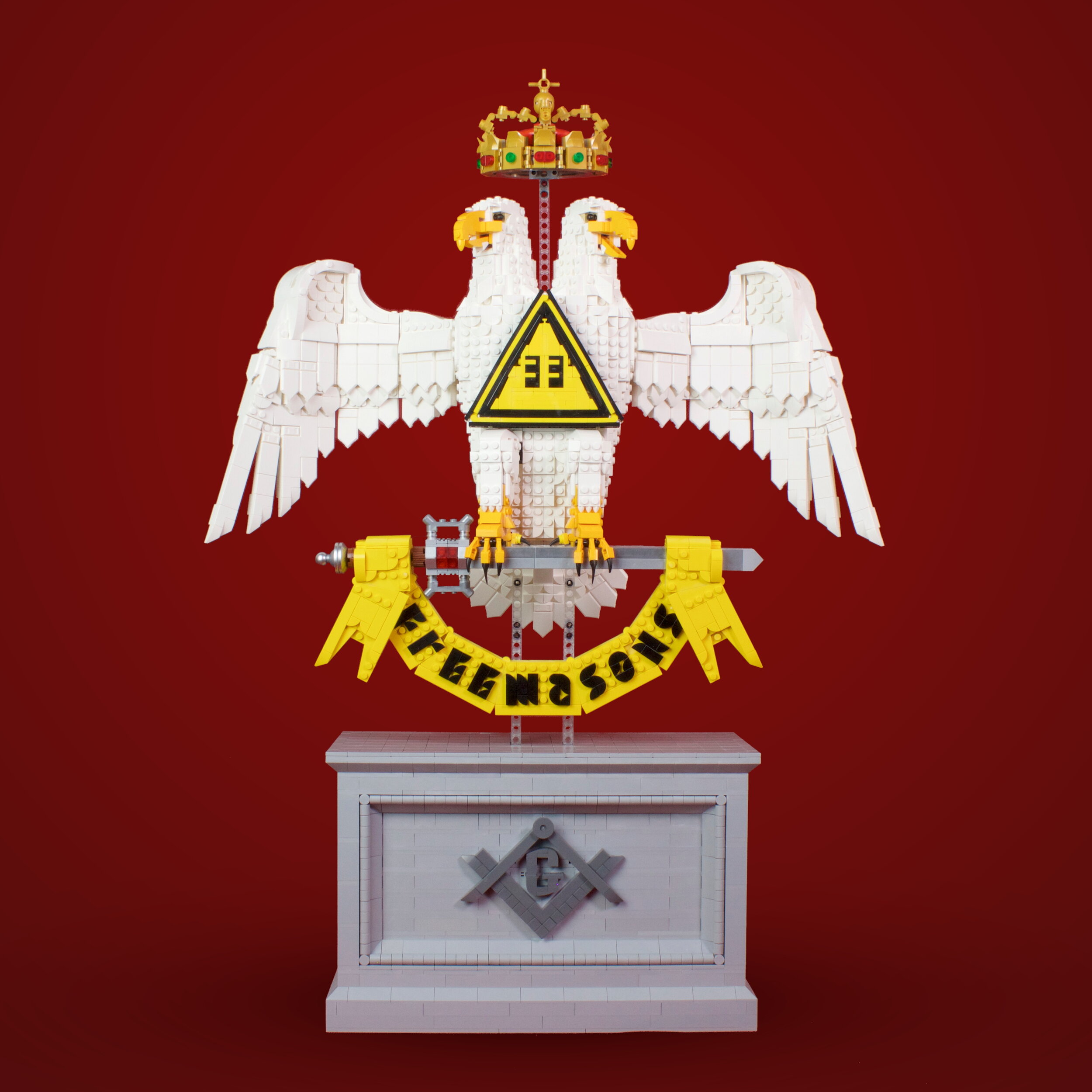I designed this enormous logo sculpture on commission for the Scottish Rite Masons in Massachusetts. Prior to this model, I had no experience with Freemasonry beyond, say, National Treasure, and I’m still no expert. Rather, to me, this project was an exercise in LEGO-izing unfamiliar iconography; it represented a chance for me to tackle a model I never would’ve thought to build on my own. When life throws me a challenge, I like to take it!
In that it’s a large-scale creature, sculpted with studs-out techniques, standing atop a big box pedestal, this Masonic Eagle logo exists in a similar vein and style to my Salesforce character pieces. However, the model also posed its own set of challenges and put forward its own unique questions.
Watch the video above for an in-depth exploration of this display piece, and read on for even more info about its design choices.
Something my client specifically requested on this model was the ability to transition it between a “32nd Degree” and “33rd Degree” version of the Scottish Rite’s logo. There are myriad degrees in Masonry, and evidently 33rd Degree is the highest one because, aside from getting a “33” on its chest, it also receives a crown hovering over the standard 2-headed eagle.
The crown is removable, sitting slotted into a notch between the eagle’s heads, while the triangular number plate is also easily interchangeable. The chest beneath the number plate is pretty flat, but it’s hidden well behind that equilateral triangle.
Without the crown, this model measures more than 24” (62cm) tall, while with the crown, it’s over 28” (72cm) tall.
This sculpture entailed a good deal of engineering, given that the majority of the model “hovers” in space, supported only by two skinny Technic columns. The columns aren’t attached to anything; rather, their slim ends slot into deep grooves in the top of the pedestal and the bottom of the eagle.
Balancing this model atop its minimal base of support wasn’t really a challenge, though, since the columns stand directly beneath the eagle’s center of mass. Since the logo is essentially symmetrical in terms of its weight distribution, there isn’t much danger of it rocking or tilting… unless you reattach the wings one at a time, rather than simultaneously.
I’m very proud of the way the logo hangs in space. It speaks to the strength of LEGO bricks themselves, that I could accomplish such an effect!
I really loved getting to design the crown. To create the round, bejeweled headband, I’m stealing a technique seen in the likes of General Grievous’ Wheel Bike and Jestro’s Evil Mobile, where twelve 2x2 sections connected by modified plates wrap around a large wheel.
The heads of the eagle were a treat to design, too. I’m happy especially with how the beaks look, as well as the subtle touch of tan around the eyes to lend them more depth.
One of the rarest bricks on this model actually appears in the crown, almost hidden by the gilding around it: a 6x6 dish in red, which hasn’t appeared in a LEGO set for nearly 15 years!
During the design process, I dreaded nothing more than designing the eagle’s wings. Their unorthodox shape, layered feathers, and dynamic posture felt so daunting to approach, especially given the huge size and, therefore, weight they’d need to be. Luckily, I emerged with a solid first draft of these after just one build session!
The final wings are even heavier and burlier than I would have expected, but the shape I managed to get here—from the splayed “finger” feathers to the wings’ horizontal concavity—made all the extra engineering worthwhile. Most of their thickness comes from the myriad layers of feathers, which double as SNOT supports that hold the wings together vertically.
Once I had designed the wings, it was fairly simple to apply a similar patterning to the tail feathers. However, with the eagle’s extremities done, I realized that my torso was looking rather furry, rather than feathery. I say “furry” because the studs-out sculpting technique I used on this model is identical to the one I employed on my Salesforce Codey and Astro models, both of which had an intentionally fuzzy texture.
To differentiate and make sleeker the eagle’s body texture, I leaned heavily on 1x1 corner round “DOTS” tiles. Then, around the base of the eagle’s necks, I added extra texture and volume by using slopes of myriad descriptions, creating that distinctive “ruff” of feathers.
Like the crown, the sword is an object meant to stand out on the design against the organically-shaped eagle. I opted to make this weapon even more distinctive by cladding it, whenever possible, in LEGO’s metallic silver color. The impact is subtle but definitely helps sell this item as being made of metal.
In the end, I needed any extra help I could get selling the sword as a sword. Since this “blade” serves the critical function of supporting a weighty banner draped over it, it actually looks more like an iron girder on close inspection! The sword is 2 studs wide and 2 studs deep along the length of the blade, just to give it the necessary strength and integrity for its structural role.
Early on in the process of this project, I knew we’d need to include a strong base of support for the model. Since the 2D version of the eagle I originally received looks very much like the model you see here—i.e., the lowest point on the logo was the bottom edge of the dangling banner—there was no way other than an added pedestal to prop up, balance, and ground the model.
I did my best to turn necessity into asset here by making the plinth decorative, not just a boring foundation. I’ve sculpted it as if it were carved from marble or granite, with classical indentations, cut-outs, and molding.
Nearly 300 of the model’s 4600+ bricks are those 1x1 double curved slopes.
There are four different brick-built fonts across this creation:
The “32/33” in the triangle
The “Freemasons” text along the hanging banner
The “G” in the compass & square emblem on the front of the pedestal
The “Not Just a Man, A Mason” slogan on the back of the pedestal
The last of these uses a font that I first encountered in the Detective’s Office modular building back in 2015. In that model, there are only 3 letters of text, though, not 17! It was time and labor-intensive to get all these letters to fit on the pedestal, and the internal rod along which they’re all strung had to be a long length of flex tubing.
I mentioned earlier up in the entry, but the wings of the model are removable… as are the heads, legs, tail, crown, number plate, sword/banner, torso and support rods! The sculpture separates into large, more manageable chunks, which makes it easier and safer to ship. My clients plan to exhibit this piece in myriad locations, so it was important to me to ensure that the model could travel as safely as possible.
In most cases, aside from the separation points of these large chunks, the model is also glued for permanence.
Thanks for reading! If you have any other questions or thoughts about this model, feel free to leave them in the comments below.




